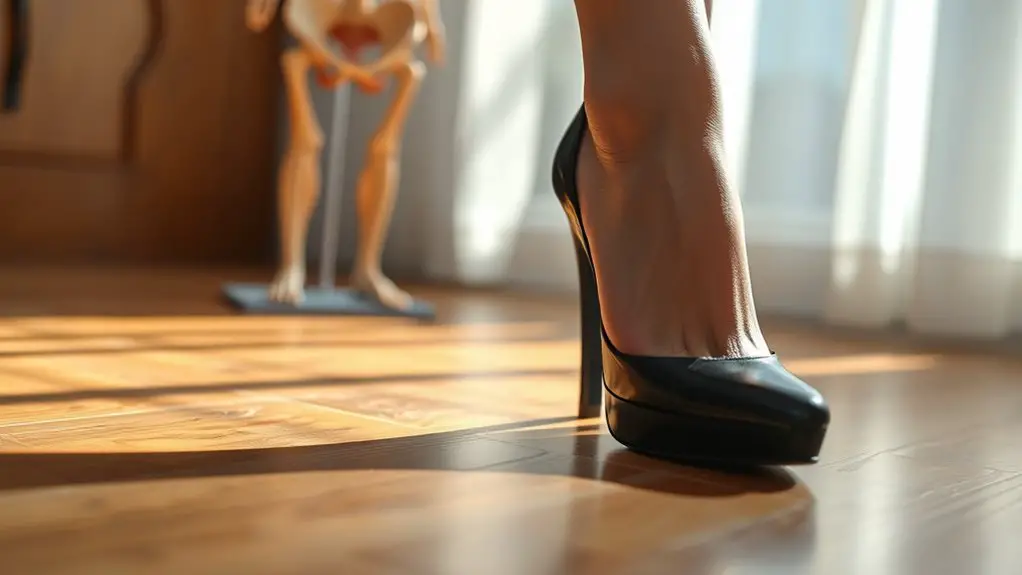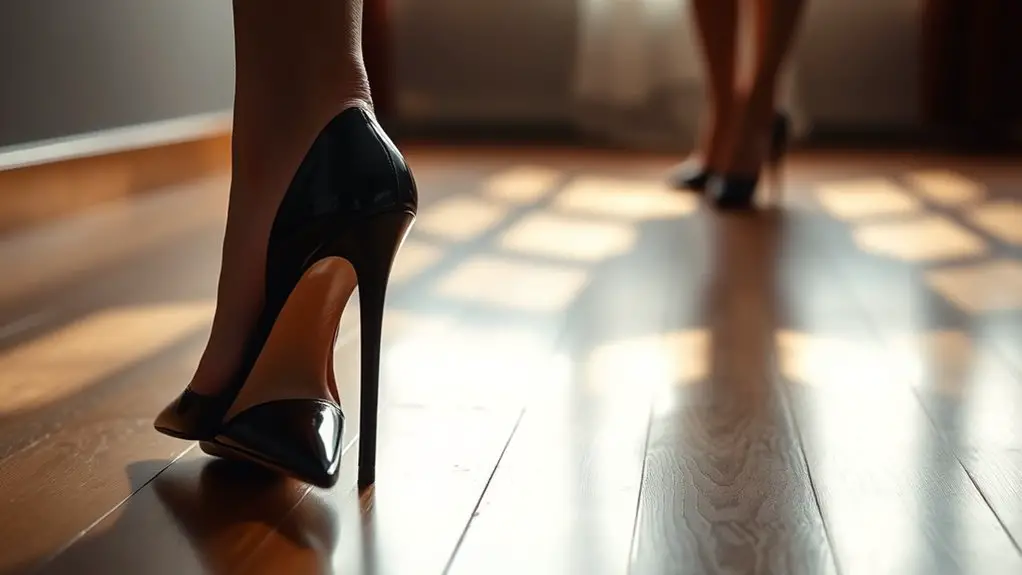Yes, wearing high heels can cause hip pain. Elevated heel positions alter your posture and mechanics, shifting weight forward and straining both your hips and lower back. This misalignment leads to increased pressure on hip joints and may result in conditions like bursitis or osteoarthritis. Additionally, prolonged wear can cause muscle imbalances and limit your hip mobility. Understanding the impact of footwear on your hip health is essential, and there are more insights available to help you manage this issue.
Understanding the Anatomy of the Hip

The hip joint is a complex structure that plays an essential role in mobility and stability. It connects the femur to the pelvic bone, allowing for a wide range of motion important for daily activities. Proper pelvic alignment is critical for maintaining an ideal hip joint function. Misalignment can lead to uneven distribution of forces across the joint, resulting in pain and reduced mobility.
The hip joint comprises the acetabulum, which houses the femoral head, and is supported by ligaments, cartilage, and muscles. These components work together to stabilize the joint during movement. When there’s an imbalance in pelvic alignment, it may cause compensatory changes in your gait, increasing stress on the hip joint. Understanding these anatomical relationships can help you appreciate the importance of maintaining proper alignment, particularly in activities that place additional strain on the hips, such as wearing heels.
How High Heels Affect Posture
When you wear high heels, your body’s posture undergoes significant changes that can affect overall alignment and stability. The increased heel height shifts your weight forward, placing extra strain on your lower back and altering your natural foot arch. This shift can lead to compensatory adjustments in your spine and pelvis, potentially resulting in discomfort and pain.
- Your center of gravity moves forward, making balance more challenging.
- Increased pressure on the forefoot can lead to instability.
- Muscles in the lower back and legs may become overworked and fatigued.
These factors contribute to a cascade of postural changes, making it essential to be mindful of how high heels can impact your body. While they may enhance your appearance, the trade-offs in posture and alignment can have lasting effects on your musculoskeletal health. Understanding these dynamics can help you make informed choices about footwear.
The Mechanics of Walking in Heels

When you wear heels, your body posture is notably altered, which affects the mechanics of your walking. This shift can lead to increased weight distribution on the forefoot, impacting balance and stability. Understanding these changes is essential for recognizing the potential risks associated with prolonged heel use.
Altered Body Posture
Although many enjoy the aesthetic appeal of high heels, walking in them considerably alters body posture and mechanics. The elevated heel position forces your body to adjust, impacting spinal curvature and overall alignment.
- Your pelvis tilts forward, increasing lumbar lordosis.
- This alteration affects wrist alignment as your arms swing differently.
- The shift in weight distribution may lead to muscle imbalances.
These changes can lead to hip pain over time, as your body compensates for the unnatural posture. Understanding the mechanics behind this shift can help you make informed footwear choices, minimizing discomfort. Ultimately, while heels may enhance your style, it’s essential to reflect on the long-term effects on your body’s alignment and pain levels.
Increased Weight Distribution
As you walk in heels, the increased weight distribution alters the biomechanics of your lower body, placing additional stress on your hips and joints. The elevated position shifts your body’s center of gravity, leading to a higher weight load on specific areas, particularly the forefoot. This change in pressure distribution can result in uneven stress across your hip joints, which may contribute to discomfort. Additionally, the muscles and ligaments in your hips have to compensate for this altered alignment, often leading to overuse and strain. Over time, this can increase the risk of hip pain and related issues. Understanding these mechanics is essential for anyone frequently wearing heels to minimize potential long-term consequences on hip health.
Common Hip Problems Associated With Heel Wear
Wearing heels can lead to several common hip problems due to altered body alignment, which shifts your center of gravity. This shift increases pressure on your hip joints and can create muscle imbalances, ultimately resulting in strain and discomfort. Understanding these issues is essential for maintaining hip health while managing your choice in footwear.
Altered Body Alignment
When high heels elevate your heels above the toes, it can lead to significant changes in body alignment, particularly affecting the hips. This altered foot alignment can restrict hip mobility and create imbalances in your lower body. Over time, these changes may contribute to various hip problems, including:
- Increased tension in the hip flexors
- Limited range of motion in the hip joint
- Misalignment of the pelvis, affecting posture
These issues stem from the way heels shift your weight and change your natural gait. By compromising the alignment of your feet and hips, wearing high heels can result in discomfort and long-term pain, making it essential to evaluate the implications of your footwear choices on body mechanics.
Increased Pressure on Joints
High heels can considerably increase pressure on your hip joints, leading to a range of common hip problems. When you wear heels, your weight shifts, creating additional joint stress, particularly in the hip area. This altered weight distribution places strain on specific pressure points, making your hips more susceptible to pain and discomfort. Over time, this can lead to conditions such as bursitis or osteoarthritis, as the continuous pressure exacerbates existing vulnerabilities in your joints. Even if you don’t feel immediate discomfort, the cumulative effects of this increased pressure can manifest as chronic pain later on. Being aware of these risks can help you make more informed decisions about your footwear choices and their impact on your hip health.
Muscle Imbalances and Strain
The biomechanics of high heels can lead to significant muscle imbalances and strain, particularly affecting the hip region. When you frequently wear heels, certain muscles become tight while others weaken, disrupting your body’s natural alignment. This imbalance can result in discomfort and pain.
To address these issues, consider the following:
- Enhancing muscle flexibility: Stretching exercises can help lengthen tight muscles, improving overall mobility.
- Strengthening weaker muscles: Focus on exercises targeting hip abductors and glutes to promote better support.
- Imbalance correction: Incorporate balance and stability training to realign your posture and reduce strain.
The Role of Footwear in Hip Pain
While many may not realize it, the choice of footwear greatly influences hip health, particularly in individuals who frequently wear heels. High heel height can alter your body’s natural alignment, leading to uneven weight distribution and increased stress on your hips. When you wear heels, the elevated position can cause your pelvis to tilt forward, which exacerbates muscle imbalances and can result in hip pain over time.
Moreover, the materials used in footwear play a significant role in comfort and support. Rigid materials may lack the necessary cushioning, causing additional strain on your joints. Conversely, flexible materials can provide better shock absorption but may not offer adequate support for high heel heights. As a result, understanding the impact of both heel height and footwear materials is essential for maintaining hip health and preventing pain. Choosing more supportive options can alleviate undue stress on your hips and enhance overall comfort.
Signs That Your Heels Are Causing Issues

Have you noticed persistent discomfort in your hips after a day in heels? This could be a sign that your footwear is impacting your body mechanics. Recognizing pain indicators early is essential for preventing long-term issues.
Persistent hip discomfort after wearing heels may indicate footwear-related body mechanics issues. Early recognition is key to preventing long-term problems.
Consider these signs of heel discomfort:
- Soreness: If you feel tightness or soreness in your hips after wearing heels, it may indicate improper alignment.
- Sharp Pain: Sudden, sharp pain during or after wearing heels can signal that your body is struggling to compensate for the unnatural posture.
- Limited Mobility: Difficulty moving your hips or a feeling of stiffness could suggest that your heels are affecting your range of motion.
Paying attention to these symptoms can help you identify whether your heels are causing problems. Ignoring these signs may lead to chronic hip pain or other complications down the line.
Tips for Choosing Heels That Minimize Discomfort
Choosing the right heels is vital for minimizing discomfort and preventing hip pain. To achieve this, consider the heel height and materials used in the construction of your shoes.
| Heel Height | Recommended Heel Materials |
|---|---|
| 1-2 inches | Soft leather or fabric |
| 2-3 inches | Cushioned soles |
| 3-4 inches | Shock-absorbing materials |
| Over 4 inches | Avoid if possible |
Opting for lower heels can reduce strain on your hips. Additionally, choosing softer heel materials can provide better support and flexibility. It’s important to avoid excessively high heels, as they can exacerbate discomfort. Always prioritize comfort over style when selecting heels, and remember to try on different styles to find the best fit for your feet. Your choice of heels can greatly impact your overall comfort and long-term hip health.
Alternative Solutions for Heel Lovers
For those who love wearing heels but are concerned about hip pain, there are several alternative solutions that can help maintain style without sacrificing comfort. Embracing heel alternatives can provide you with options that are both chic and functional.
- Stylish Flats: Opt for fashionable flats that have supportive cushioning to reduce pressure on your hips.
- Low-heeled Shoes: Choose low-heeled options that offer a slight elevation without the excessive height of traditional heels, promoting better posture.
- Arch Support: Look for shoes with built-in arch support, which can help distribute weight evenly and alleviate discomfort.
Exercises to Strengthen Hips and Alleviate Pain
While wearing heels can enhance your style, it’s important to address the potential for hip pain associated with them. Engaging in targeted exercises can provide significant hip strengthening and pain relief. Start with glute bridges; lie on your back, knees bent, and lift your hips towards the ceiling, holding for a few seconds before lowering. This exercise activates the glutes and stabilizes the hips.
Next, incorporate clamshells. Lying on your side with knees bent, lift the top knee while keeping your feet together. This strengthens the hip abductors, vital for maintaining proper alignment.
Don’t forget about hip flexor stretches. Kneel on one knee, pushing your hips forward to stretch the front of the hip. Regular practice of these exercises not only helps alleviate current pain but also strengthens the hips, reducing the risk of further issues when you wear heels.
When to Seek Professional Help for Hip Pain
If you experience persistent hip pain that interferes with your daily activities or worsens over time, it’s important to consult a healthcare professional. Recognizing when to seek professional help can greatly influence your recovery and overall quality of life. Here are some indicators that warrant attention:
Persistent hip pain can significantly impact your daily life; don’t hesitate to seek professional help for effective recovery.
- Pain lasting more than a few days: If your discomfort doesn’t improve with rest or self-care, it’s time to consult an expert.
- Difficulty in mobility: If you’re struggling to walk, climb stairs, or perform basic movements, professional evaluation is vital.
- Accompanying symptoms: If you experience swelling, redness, or fever along with hip pain, these may indicate a more serious condition.
Don’t ignore your body’s signals. Seeking professional help early can lead to effective treatment strategies and prevent further complications. Prioritize your health and well-being.
Frequently Asked Questions
Can Heel Height Impact the Severity of Hip Pain?
Heel height can greatly impact hip pain severity due to altered heel biomechanics and foot alignment. Higher heels often disrupt natural posture, leading to misalignment that may exacerbate discomfort in the hips and surrounding areas.
Are Certain Heel Styles Better for Hip Health?
Imagine strutting in stilettos while your hips protest. Certain heel types, like block heels, offer better stability and comfort features. Prioritizing these can greatly enhance your hip health, reducing discomfort during prolonged wear.
How Often Should I Wear Heels to Avoid Hip Pain?
To manage pain effectively, consider limiting heel frequency to special occasions rather than daily wear. This approach helps minimize strain on your hips, promoting better alignment and reducing the risk of discomfort associated with prolonged heel use.
Can Weight Gain Worsen Hip Pain From Heels?
Yes, weight gain can worsen hip pain from heels. Increased weight alters weight distribution, leading to greater joint stress. This extra pressure can exacerbate discomfort, especially when wearing heels that already strain your hips.
Do Age and Activity Level Affect Heel-Related Hip Pain?
As you age, joint flexibility decreases, and muscle strength can diminish. These age factors, combined with your activity influence—whether you’re active or sedentary—can greatly impact how heel-related hip pain manifests and progresses over time.



